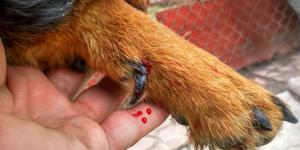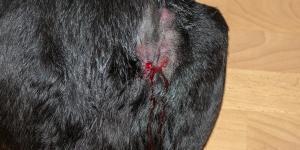My Dog Has a Bite Wound From Another Dog



See files for Dogs
The domestication of our dogs has given canines a special place in terms of their relationship to humans. We can co-exist in harmony thanks to training and adaptation. In this context, it is important to remember they are still an animal. They will react to certain situations and environments in ways which we may find surprising. Getting in a fight with another dog is one of them. Even if the dog is well-balanced, another dog can pose sufficient enough a threat to attack them. The dog will try to defend themselves and may receive a bite injury in the process.
At AnimalWised, we detail what happens when my dog has a bite wound from another dog. We look at what you need to administer in terms of first aid and further treatment, as well as how you can best avoid a dog being bitten by another dog in the future.
When a dog is bitten by another dog
If your dog is attacked by another dog, there are gradations of the trauma suffered. Some dogs may not have any physical marks, others may have scratches from their claws, some will have puncture wounds and, in the most severe cases, the dog can be mauled with many serious wounds.
We may or may not have witnessed the attack on our dog. If we allow our dog to be in the yard unsupervised or they are off-leash and out of eyesight in public, we may miss the altercation itself. This can make thins difficult since we don't know the state of the other dog. This is a particular worry since there is a risk of rabies. Even if the wound doesn't look infected, the rabies virus may have entered their blood.
For this reason, we can provide first aid for the dog to stop bleeding and clean the wound, but it is best to take the dog to a veterinary clinic. We explain why in the following sections.
Before we do, you may find it helpful to know how to stop two dogs from fighting to prevent either being bitten in the first place.
Urgent veterinary care
Dog fights are often very stressful situations for guardians. This is especially so when serious injuries occur, resulting in bleeding, open wounds or even internal damage. Regardless of the severity of the event, it is important to go to an emergency veterinary center to:
- Evaluate the general condition of the animal
- Treat the wound properly
Only in this way will we be able to avoid the possible complications associated with bite wounds.
Evaluation of the general condition
In the case of serious attacks, it is possible vital bodily systems are affected or significant hemorrhages occur. Both compromise the life of the animal. Before proceeding to treat the wounds, it is essential to carry out a complete and exhaustive examination of the animal. This may require certain diagnostic tests such as X-rays or ultrasound). This helps to establish the appropriate treatment to stabilize the animal.
Even if we cannot see a severe looking wound, it is possible that some could be hidden by long or dense fur. Internal injuries could also have occurred. Going to the veterinarian means a comprehensive examination can be carried out to avoid missing any injuries.
Wound treatment
Bite wounds are considered intrinsically contaminated, so they should never be sutured. When a dog is bitten by another dog, the bacteria present in the mouth are inoculated into the tissue. In this sense, a puncture wound acts for bacteria similarly to how a syringe injects medicine. Bacteria give rise to an inflammatory process that has to drain to the outside. It is for this reason you may see your dog is bitten by another dog and swelling.
By suturing the tissue, the drainage of inflammatory fluids may be prevented. It is important to leave the wound open so that both deep tissue and superficial skin layers are able to heal.
With this in mind, the healing of the contaminated wound should be based on the following factors:
- Careful shaving of the area adjacent to the wound: the presence of hair can hinder healing.
- Soapy solution washes: an antiseptic soapy solution (with betadine or chlorhexidine soap) is usually used to remove any remaining dirt and reduce the bacterial load in the wound. Products such as alcohol or hydrogen peroxide should never be used as they are very irritating and make it difficult for the wound to heal.
- Application of dressings: dressings are medical devices that are used to cover and protect wounds. In addition to providing pain relief, they absorb wound exudate and promote proper blood circulation. These help to optimize the healing process.
- Elizabethan collar placement: to prevent the animal from scratching, licking or biting the affected areas.

Aftercare for wound treatment in dogs
As we have seen, the first treatment of the bite should always be carried out in a veterinary center. Once the dog is stabilized and they no longer need veterinary treatment, they will be discharged. When this occurs, the veterinarian will provide guidelines on continued home treatment and aftercare. Below we detail the general guidelines for continued wound treatment.
Generally, 2-3 daily administrations should be performed. These are:
- Dressing removal
- Cleaning the wound with an antiseptic solution: antiseptics should never be used undiluted as they can be irritating. Betadine (povidone iodine) should be diluted to 10% and chlorhexidine to 40%. Once diluted, gauze should be soaked in the solution and the wound carefully cleaned to remove any remaining exudate (seepage from the wound). Cotton can leave remains in the would. Alcohol or hydrogen peroxide should never be used to clean the wound as they cause irritation and cell death.
- Placement of a new dressing

Infection treatment
As we have mentioned in previous sections, bite wounds are considered intrinsically contaminated due to the direct transfer of bacteria present in the other dog's mouth. For this reason, it is essential to establish an antibiotic treatment to control the infection and promote the healing of the affected tissues. These antibiotics should be prescribed by the veterinarian. Never used antibiotics intended for human use on your dog.
Here we provide a full guide to administering first aid to a dog's bite wound.
Healing stimulation
In the case of very extensive, deep wounds or animals with poor immune response, some strategies can be used to promote wound healing:
- Debridement: consists of scraping the edges of the wound with a scalpel to stimulate bleeding and promote wound healing. This procedure can only be performed by veterinary professionals.
- Laser therapy: laser therapy promotes the healing process by stimulating collagen production and cell regeneration.
- Healing ointments: these ointments contain enzymes that hydrolyze all those components that prevent wound healing.
If you want to know more about other types of dog wounds, take a look at our article on healing a dog's paw pad injury.
My dog has a puncture wound from another dog
After an aggression or fight between dogs, their handlers often wonder what to do if my dog is bitten and has a puncture wound. After the first veterinary examination, it is important that caregivers carry out proper management of the bite at home. The correct healing and healing of the wound will depend on it.
The care that the guardians of these animals must carry out are the following:
- Dress and clean the wound: follow the guidelines of the veterinarian who attended the animal.
- Administer drugs: those that have been prescribed by the veterinarian (antibiotics, analgesics, healing ointments, etc.)
- Go to the veterinarian: for scheduled check-ups or in case of any anomaly in the wound or in the behavior of the animal
- Provide a quiet place and maintain a relaxed routine: animals that suffer aggression experience a situation of great stress, so it is important to provide them with as calm an environment as possible until they fully recover.

How to prevent my dog from being bitten by another dog
Aggressions or fights between dogs are almost always avoidable situations. To better promote our dog's health and well-being, there are practical considerations we can make to avoid dangerous situations with other dogs:
- Ensuring proper education and socialization: this is the most important factor in achieving well-balanced dogs that know how to deal with different situations and interact appropriately with other animals. Even in tense altercations with more dominant animals, a balanced dog will know how to deal with the situation and respond proportionally. Learn more with our guide to socializing dogs.
- Walk dogs on a leash: while it is important to allow our dog to run off-leash where possible, we need to keep them on a leash when stranger dogs or other dangers are present. We should promote a feeling of security when another dog is around, so do not tug or put tension on the leash. See what you need to avoid with our article on the mistakes we make when walking dogs on a leash.
- Anticipate conflict: for example, before entering an enclosure where there is another loose dog, speak to the guardian about the temperament of their pet. Very territorial dogs may consider an animal that enters their area an intruder and, as a consequence, a situation of tension may arise between them.
- Pay attention to the character and emotional state of our dog: dogs with a high level of stress or with a very strong temperament may be more prone to generating tense situations with other dogs. In these cases, it is advisable to request the help of a canine educator who can give us the appropriate guidelines to correct or improve relationships with other animals.
This article is purely informative. AnimalWised does not have the authority to prescribe any veterinary treatment or create a diagnosis. We invite you to take your pet to the veterinarian if they are suffering from any condition or pain.
If you want to read similar articles to My Dog Has a Bite Wound From Another Dog, we recommend you visit our First aid category.








